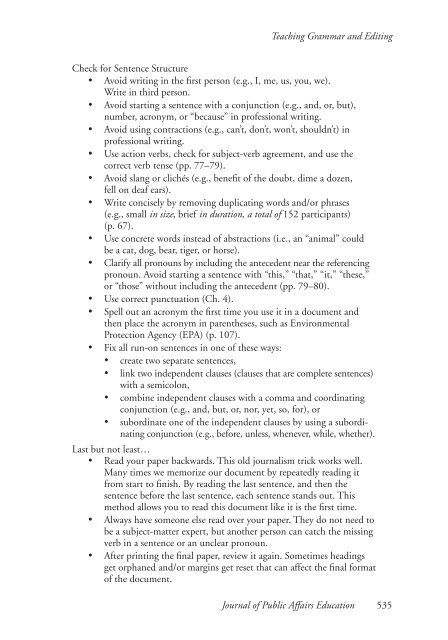Teaching Grammar and Editing in Public Administration ... - Naspaa
Teaching Grammar and Editing in Public Administration ... - Naspaa
Teaching Grammar and Editing in Public Administration ... - Naspaa
You also want an ePaper? Increase the reach of your titles
YUMPU automatically turns print PDFs into web optimized ePapers that Google loves.
<strong>Teach<strong>in</strong>g</strong> <strong>Grammar</strong> <strong>and</strong> <strong>Edit<strong>in</strong>g</strong><br />
Check for Sentence Structure<br />
• Avoid writ<strong>in</strong>g <strong>in</strong> the first person (e.g., I, me, us, you, we).<br />
Write <strong>in</strong> third person.<br />
• Avoid start<strong>in</strong>g a sentence with a conjunction (e.g., <strong>and</strong>, or, but),<br />
number, acronym, or “because” <strong>in</strong> professional writ<strong>in</strong>g.<br />
• Avoid us<strong>in</strong>g contractions (e.g., can’t, don’t, won’t, shouldn’t) <strong>in</strong><br />
professional writ<strong>in</strong>g.<br />
• Use action verbs, check for subject-verb agreement, <strong>and</strong> use the<br />
correct verb tense (pp. 77–79).<br />
• Avoid slang or clichés (e.g., benefit of the doubt, dime a dozen,<br />
fell on deaf ears).<br />
• Write concisely by remov<strong>in</strong>g duplicat<strong>in</strong>g words <strong>and</strong>/or phrases<br />
(e.g., small <strong>in</strong> size, brief <strong>in</strong> duration, a total of 152 participants)<br />
(p. 67).<br />
• Use concrete words <strong>in</strong>stead of abstractions (i.e., an “animal” could<br />
be a cat, dog, bear, tiger, or horse).<br />
• Clarify all pronouns by <strong>in</strong>clud<strong>in</strong>g the antecedent near the referenc<strong>in</strong>g<br />
pronoun. Avoid start<strong>in</strong>g a sentence with “this,” “that,” “it,” “these,”<br />
or “those” without <strong>in</strong>clud<strong>in</strong>g the antecedent (pp. 79–80).<br />
• Use correct punctuation (Ch. 4).<br />
• Spell out an acronym the first time you use it <strong>in</strong> a document <strong>and</strong><br />
then place the acronym <strong>in</strong> parentheses, such as Environmental<br />
Protection Agency (EPA) (p. 107).<br />
• Fix all run-on sentences <strong>in</strong> one of these ways:<br />
• create two separate sentences,<br />
• l<strong>in</strong>k two <strong>in</strong>dependent clauses (clauses that are complete sentences)<br />
with a semicolon,<br />
• comb<strong>in</strong>e <strong>in</strong>dependent clauses with a comma <strong>and</strong> coord<strong>in</strong>at<strong>in</strong>g<br />
conjunction (e.g., <strong>and</strong>, but, or, nor, yet, so, for), or<br />
• subord<strong>in</strong>ate one of the <strong>in</strong>dependent clauses by us<strong>in</strong>g a subord<strong>in</strong>at<strong>in</strong>g<br />
conjunction (e.g., before, unless, whenever, while, whether).<br />
Last but not least…<br />
• Read your paper backwards. This old journalism trick works well.<br />
Many times we memorize our document by repeatedly read<strong>in</strong>g it<br />
from start to f<strong>in</strong>ish. By read<strong>in</strong>g the last sentence, <strong>and</strong> then the<br />
sentence before the last sentence, each sentence st<strong>and</strong>s out. This<br />
method allows you to read this document like it is the first time.<br />
• Always have someone else read over your paper. They do not need to<br />
be a subject-matter expert, but another person can catch the miss<strong>in</strong>g<br />
verb <strong>in</strong> a sentence or an unclear pronoun.<br />
• After pr<strong>in</strong>t<strong>in</strong>g the f<strong>in</strong>al paper, review it aga<strong>in</strong>. Sometimes head<strong>in</strong>gs<br />
get orphaned <strong>and</strong>/or marg<strong>in</strong>s get reset that can affect the f<strong>in</strong>al format<br />
of the document.<br />
Journal of <strong>Public</strong> Affairs Education 535
















